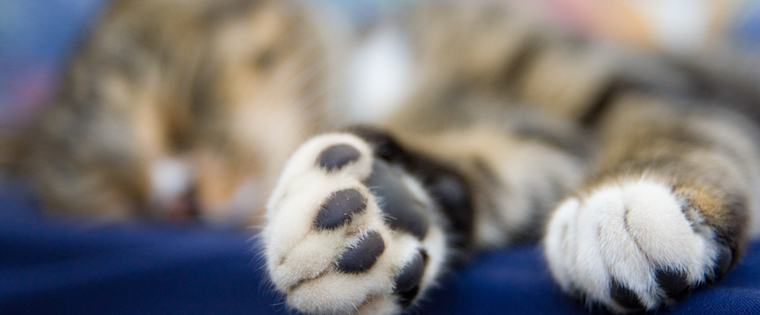Like you, your pets are on their feet most of the day. And like you, that means their feet need some TLC. And while you might spoil yourself with a pedicure or a massage, you know that the simplest way to keep your feet happy and healthy is to keep nails trimmed and feet clean. So what are you doing to help with the basics of pet paw care? Your cats and dogs also need trim nails and clean paws (and will also appreciate a little spoiling of paw care). So how can you do this care at home?
Basic Care for Cat Paws
You first need to get your cats accustomed to your checking their feet, so make sure that holding and lightly massaging their paws is part of your cuddle time. Add treats to help them relax if they don’t like having their paws touched. Taking the time to build up this trust will make the following steps easier.
Follow these steps regularly to take care of your cats’ paws at home.
- Check paws regularly. Your cats can get a lot of things stuck in those tiny paws. When they’re on your lap or curled on the couch, inspect their paws, especially between the toe pads, for thorns, dirt, stones, cuts or sores. If you find splinters or other intruders, remove them with a tweezer. Apply a gentle soap to clean wounds. For more serious problems, visit your vet.
- Wipe paws clean. Chemicals, trash and dirt can stick to cats’ paws, which they may later try to lick clean. Help your cats’ paws (and tummy) by wiping their paws with a damp cloth every day, or at least on days when they’ve been exploring or gotten into something new.
- Let her scratch. Cats needs to scratch their nails to keep them trim and healthy. Provide safe places where your cats are allowed to scratch (like cat scratching posts). If they don’t scratch regularly, you’ll need to trim nails at home.
- Trim cat’s nails. Most cats need their nails clipped every two weeks. You’ll need to work for a while to get your cats comfortable with having their paws squeezed and clippers near them (find nail clipping tips and videos online to prepare). Make sure you use clippers made for cat nails, and that you’re careful to cut only the white part of the nail – never the pink part (the quick). And remember, few people ever trim all of their cat’s nails in one sitting. Prepare for this to be a project done a little bit at a time. If you or your cat aren’t up for home nail trimming, visit a vet (ACOW trims nails) or groomer regularly to do this for you.
- Trim long hair. For long-haired cats, the longer hairs that grow between toe pads may become irritating. If your cats seem bothered (usually shown by obsessively licking), then trim the hair that grows around their paws.
Basic Care for Dog Paws
A little care done at home can prevent a lot of problems with your dog’s paws. Follow these steps to keep your dog’s paws healthy.
- Check paws regularly. Just like with cats, dogs may track in debris or get items stuck between their toes. Every day – and especially after big outings – check your dog’s paws for any injuries. Wipe off dirt and treat minor cuts with gentle soap and water.
- Trim dog nails. To prevent injury or discomfort, keep your dog’s nails trimmed so they are just barely above the ground. If you hear loud clicking when your dog walks on a hard surface, then it’s time for a trim. Use clippers designed for dog nails and offer lots of treats and a calm attitude when trimming. If you can’t do this at home, visit the vet or groomer when nail trims are needed.
- Trim hair around paws. Hairy paws are more likely to get dirty or irritated. Keep the hair above and around paws trimmed short to avoid these problems.
- Moisturize. Most dogs will benefit from having a moisturizer applied to their paws regularly. This will relieve some of the dry caking and damage, and is especially important after particularly hot, cold or rocky excursions. Use only moisturizers made for dogs, as human products can have dangerous chemicals.
Paw Care in Summer and Winter
Summer’s heat and winter’s frost can damage pet paws. If your pet needs to go outside during extreme weather, try not to walk on sidewalks, asphalt, or other surfaces that hold heat or ice. Consider dog booties for dogs who need to walk in extreme weather. You can also moisturize paws with pet-friendly products to ease irritation before or after venturing outside.
How to Care for Injured Paws
If you find wounds on your pet’s paws, you may be able to treat them at home. Minor wound care for pets is much like it is for humans: clean the area with antibacterial wash or gentle soap and water. Apply a bandage (usually wrapped cloth tape) to keep the area clean and protected. That said, if the injury doesn’t heal quickly, if your pet chews on or further irritates the injury, or if they start limping, visit your veterinarian.




